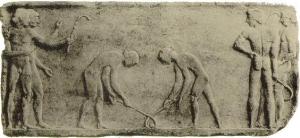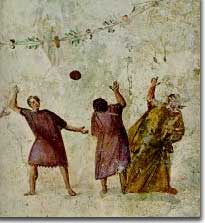8. Football classics: Ball games in ancient Greece and Rome
If the public had Christians being thrown to the lions to look forward to, a few people running around after a ball, however violent, might have looked a bit tame in comparison.
 The Greeks set new standards for organised spectator sports in Europe. But team sports never featured in the Ancient Olympics, and although some rather imaginative interpretations of ancient texts have suggested they played some kind of rugby, neither do ball games appear to have been particularly prominent in Hellenic culture.
The Greeks set new standards for organised spectator sports in Europe. But team sports never featured in the Ancient Olympics, and although some rather imaginative interpretations of ancient texts have suggested they played some kind of rugby, neither do ball games appear to have been particularly prominent in Hellenic culture.
They did have balls, including the small hard ‘episkyros’ that was probably hit with a bat or stick, and the larger stuffed ‘follis’. A handful of images from the era depict people playing with these, including the one that appears on the Champions League trophy today in which a man is controlling a ball with his knee, although it is hard to work out exactly what the sports being shown really entailed.
 Greek literature usually only briefly mentions these games in passing, such as Nausicaa and her friends tossing a ball to and fro in Homer’s Odyssey, or the essayist Plutarch commenting that “ball players have to learn have to catch the ball as well as how to throw it” when advocating a more practical school system. Only two known Greek texts provide any kind of detail. Julius Pollux outlines a game in which two opposing teams stood on either side of a line and threw the ball at each other, and his contemporary Athenaeus describes ‘phaininda’, a clearly physical ball game that includes plenty of throwing, dodging and scrimmaging.
Greek literature usually only briefly mentions these games in passing, such as Nausicaa and her friends tossing a ball to and fro in Homer’s Odyssey, or the essayist Plutarch commenting that “ball players have to learn have to catch the ball as well as how to throw it” when advocating a more practical school system. Only two known Greek texts provide any kind of detail. Julius Pollux outlines a game in which two opposing teams stood on either side of a line and threw the ball at each other, and his contemporary Athenaeus describes ‘phaininda’, a clearly physical ball game that includes plenty of throwing, dodging and scrimmaging.
Greek ball games would appear to have been rather like the kind of piggy-in-the-middle or dodgeball played in school playgrounds today, or perhaps gymnastic displays of skill. One of the key elements required for a game to be considered football, namely the scoring of goals of some sort, is not recorded.
 Several Romans writers admitted that the art of ball-play was something they had learned from the Greeks. But the idea that the Romans transformed it into ‘harpastum’, a particularly barbaric form of rugby, seems to have come more from over-imaginative 19th century textbooks and 21st century websites than any historically demonstrable facts. The ‘real’ evidence consists of such texts as Martials’ “when you are stripped and playing trigon, may the approving judgement of the ring of players looking on assign the palm to you, and not give higher praise to Polybus’ left-handers.” And these don’t really tell us very much at all.
Several Romans writers admitted that the art of ball-play was something they had learned from the Greeks. But the idea that the Romans transformed it into ‘harpastum’, a particularly barbaric form of rugby, seems to have come more from over-imaginative 19th century textbooks and 21st century websites than any historically demonstrable facts. The ‘real’ evidence consists of such texts as Martials’ “when you are stripped and playing trigon, may the approving judgement of the ring of players looking on assign the palm to you, and not give higher praise to Polybus’ left-handers.” And these don’t really tell us very much at all.
Gruesome blood sports in the amphitheatres were undoubtedly part of Roman culture, but the short descriptions of ‘harpastum’ and similar games like ‘trigon’, ‘expulsim ludere’ and ‘pila paganica’ suggest that Roman ball games, like the Greek ones, were little more than variations on the dodgeball theme.
Galen’s treatise On Exercising with a Small Ball describes ‘harpastum’ as a game in which the basic idea is clearly to throw the ball to one another and stop the ‘man in the middle’ from getting it. And even though this game included an element of wrestling, in Galen’s opinion, and unlike running or horse-riding, “it entails no danger.”
 It’s a long way from that to the story, unsubstantiated by any evidence, that Julius Caesar was so unimpressed to learn that only 25 men had died in the morning’s ‘harpastum’ session that unless the body count was increased, he’d be declaring a game to only be played by women. If the Romans played anything like rugby at all, then we have no real surviving proof of it.
It’s a long way from that to the story, unsubstantiated by any evidence, that Julius Caesar was so unimpressed to learn that only 25 men had died in the morning’s ‘harpastum’ session that unless the body count was increased, he’d be declaring a game to only be played by women. If the Romans played anything like rugby at all, then we have no real surviving proof of it.
Which makes it all the stranger that there are so many legends in Britain of football having been introduced by the Romans. Such tales as the one that a victory over the invaders in Derbyshire in 217 was celebrated with a football match are more local traditions than historical fact. The discovery of what is supposed to be a harpastum court at Caerleon in Wales in 2005 is also questionable, as not even in Italy is there any surviving evidence of what such a thing, should it have existed, would have looked like.
Click here to buy the book and read the whole story.

Leave a comment
Comments 0